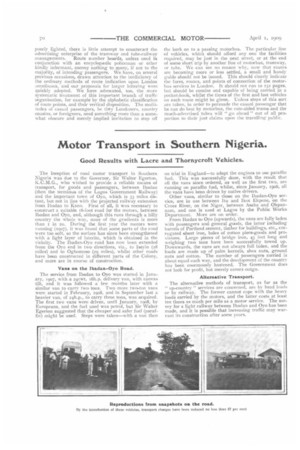Motor Transport in Southern Nigeria.
Page 2

If you've noticed an error in this article please click here to report it so we can fix it.
Good Results with Lacre and Thornycroft Vehicles.
The inception of road motor transport in Southern Nigeria was due to the Governor, Sir Walter Egerton, K.C.M.G., who wished to provide a reliable means of transport, for goods and passengers, between Ibadan (then the terminus of the Lagos Government Railway) and the important town of Oyo, which is 33 miles distant, but not in line with the projected railway extension from Ibadan to Kano. First of all, it was necessary to construct a suitable t8-foot road for the motors, between Ibadan and Oyo, and, although this runs through a hilly country the whole way, none of the gradients is more than i in 20. During the first year the motors were running (1907), it was found that some parts of the road were too soft, so the surface has since been strengthened with a light layer of laterite, which is obtained in the vicinity. The Ibadan-Oyo road has now been extended from the Oyo end in two directions, viz., to Iseyin (28 miles) and to Ogbomoso (29 miles), whilst other roads have been constructed in different parts of the Colony, and more are in course of construction.
Vans on the Ibadan-Oyo Road.
The service from Ibadan to Oyo was started in January, 1907, with a 24cwt. 16h.p. delivery van, with canvas tilt, and it was followed a few months later with a similar van to carry two tons. Two more two-ton vans were started in February, 1908, and in September last a heavier van, of 24h.p., to carry three tons, was acquired. The first two vans were driven, until January, 19438, by Europeans, and the fuel used was petrol, but Sir Walter Egerton suggested that the cheaper and safer fuel (paraffin) might be used. Steps were taken—with a van then on trial in England—to adapt the engines to use paraffin fuel. This was successfully done, with the result that all the vans since ordered, as well as the first two, are running on paraffin fuel, whilst, since January, 1908, all the vans have been driven by native drivers. Other vans, similar to those on the Ibadan-Oyo service, are in use between Itu and Ikot Ekpene, on the Cross River, on the Niger, between Asaba and Okpannam, and one is used at Lagos by the Public Works Department. More are on order. From Ibadan to Oyo (upwards), the vans are fully laden with passengers and general goods, the latter including barrels of Portland cement, timber for buildings, etc., corrugated sheet iron, bales of cotton piece-goods and provisions. Large pieces of bridge iron, 43 feet long and weighing two tons have been successfully towed up. Downwards, the vans are not always full laden, and the loads are made up of palm kernels, shea nuts, ground nuts and cotton. The number of passengers carried is about equal each way, and the development of the country has been enormously hastened. The Government does not look for profit, but merely covers outgo.
Alternative Transport.
The alternative methods of transport, as far as the " up-country " services are concerned, are by head loads or by railway. The former cannot cope with the heavy loads carried by the motors, and the latter costs at least ten times as much per mile as a motor service. The survey for a light railway between Ibadan and Oyo has been made, and it is possible that increasing traffic may warrant its construction after some years.






















